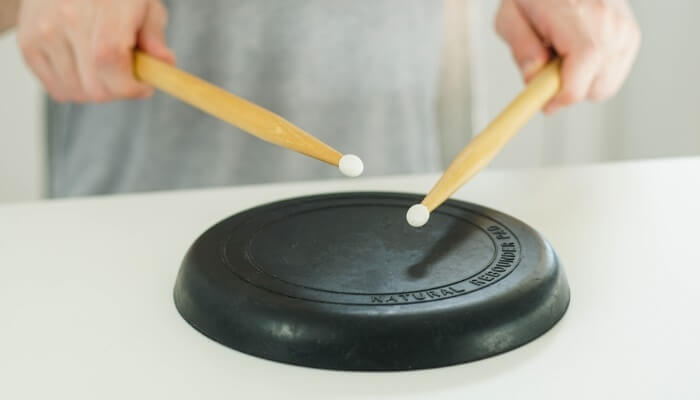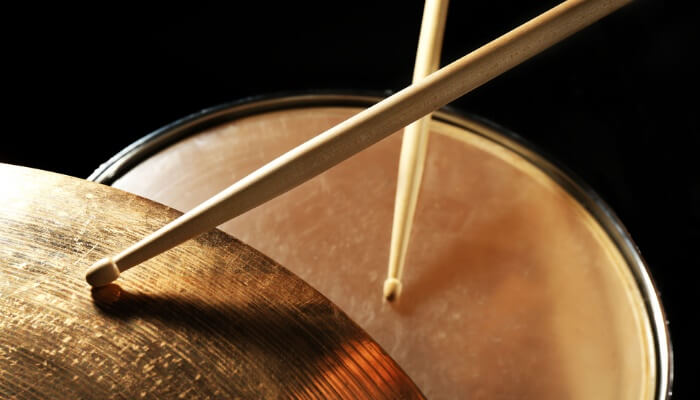No one is born to be a professional drummer, and you need to go through a process of practice. However, poor training will slow down your progress.
How to practice drumming methodically and properly? Let’s explore basic drum exercises for beginners in this article.
Let’s read on to discover right now!
Drum Warm-Up Exercises

Like any other physical activity, you also need to warm up before hitting the drums to encourage coordination of the limbs.
There are many different warm-up exercises with varying degrees of difficulty. To make practice convenient, choose activities suitable for your skill level.
An appropriate warm-up time will fall between 5 and 15 minutes before the performance begins.
For those new to the drums, try using the metronome during warm-up. It helps to increase your sense of rhythm over time.
In addition, the practice pad will be a good alternative for those who live in densely populated areas. You can also use an electronic drum kit to reduce the noise generated when practicing.
Practice Drum Pad Exercises

Let’s start by looking at basic drumming exercises first. Another name for them is drum rudiments.
These exercises are often used for warm-ups or drills. From its basics, you can develop rudiments into more complex ones.
You can use these exercises to warm up on the drum pad. They are playable on one surface.
You can check out the video below for a visual guide to these rudiments.
Single Stroke Roll
This foundational exercise is often interpreted to the beat, drum solos, and fills. No matter what skill level you have, it plays a huge role.
You can use simple alternating strokes R, L, R, and L to make a single-stroke roll. When swinging the club with each stroke, their height should be the same.
In addition, make sure the volume of the sticks is also equal to evenness.
You can start practicing with a drum pad. Once you’re more proficient, practice with a metronome to increase your speed and endurance.
To get a closer look at your hands, practicing in frdouble-strokeor can also help.
Double Stroke Roll
The double stroke roll lays the foundation for all the rudiments that drummers must master. Its other name is long roll.
The pattern of the double stroke roll will be in the form R, R, L, L, R, R, L, L. If you are left-handed, reverse the order of the patterns.
The first note in the double stroke is also known as the “primary stroke,” followed by the “secondary stroke.” Make sure the volume and height of your swing are the same to avoid awkward sounds.
To play long rolls quickly, you need to make sure the secondary stroke bounces back.

Single Paradiddle
The single paradiddle consists of the notes the drummer needs to play consecutively. A double stroke follows every single stroke.
The notation will look like this: R, L, R, R, L, R, L, L (right, left, right, right, left, right, left, left).
You will practice this rudiment at a slow to fast pace. When playing faster, make sure your drumsticks bounce well to eliminate double strokes.
One note not to forget is to make sure the notes have the same bar height. They will help the volume come out more evenly.
Once you’ve mastered this exercise, try putting stress on each of the first notes in a four-note set. At the same time, make sure to lower the volume of the remaining notes.
This process will help you recognize the rhythm and the kinetics of specific notes more quickly.
Double Paradiddle
The double paradiddle is a rudiment pattern consisting of 12 notes. It’s common in-fills and beats with a triplet or 12/8 feel.
This drumming style is perfectly compatible with the timbre and melodies of Latin and Jazz music.
Compared to single paradiddle, their most basic difference is that you will play four single strokes alternating instead of double. They will have the symbols R, L, R, L, R, R L, R, L, R, L, L.
Let’s start with four single strokes alternating left and right, then move on to a double. Flip the order of notes once, and you have a double paradiddle.
Triplets (Single Stroke Seven)
The triplets are a brand-new rudiment. The Percussive Arts Society recommended this exercise to add variety to your practice.
This short exercise takes the form of 7-stroke single-stroke rolls (R, L, R, L, R, L, R). You can play it as a trio of sextuplets or a sixteenth note.
The two most common uses of triplets are in marching bands or marching music.
Flam-Tap
Flam tap is a basic rudiment that integrates basic flam into double-stroke patterns. It has various applications, such as musical drum solos, beats, and fill patterns.
A flam-tap is a combination of double-stroke rolls with flams. This rudiment contains:
- The main note is where you need to count the beat when hitting.
- A grace note is located right in front of the main note.
In the notation, you will see that the size of the grace notes is usually smaller and uncounted. Their effect is to decorate the main notes.
The drummer will keep the club upright or tilted at a 45-degree angle when playing the main note. At the same time, when playing grace notes, the club head is only about 1 inch from the empty surface.
When playing a flam-tap, the drummer will use the stick to hit the main note hitting an additional tap stroke.
Drum Exercises For Speed
Speed is a must if you want to fly around the drum kit like a pro and virtuoso. Practice increasing your speed with this simple daily exercise.
First, it would help to choose a regularly played beat to warm up at a normal pace. Start very quietly and slowly.
After a few minutes, once you’ve gotten used to them, turn the volume up a bit. When the volume reaches the maximum, push the tempo to the fastest level.
Finally, you return to the original rhythm and volume. This exercise will help your hands become more flexible.
During exercise, always keep your muscles relaxed. Another note is to arrange the drum kit in the most convenient position.
You can also use heavier drumsticks when practicing. You won’t have much trouble switching to the official kit.
Basic Snare Drum Exercises

The basic snare drum exercises are about playing the snare drum beats separately from the rest of the rhythms produced by your chi.
The recommended exercise for those just starting is to focus on the kit’s two hi-hat and snare drum voices. The exercises on the left will also be easier for you.
Try switching the drummer to the right to add a steady bass to the tune as you get better at it.
If your level is advanced, you can play snare patterns on more complex patterns.
Instead of repetition, this exercise gives you the freedom to apply any number of drum beats to your tunes. Try adding your personality by mixing tunes.
Bass Drum Independence Exercises
Bass drum independence exercises allow you to play the beats of this type of drum independently. It has a similar operation to the above snare drum exercise.
Good advice for newbies is to focus only on the two voices on the drum set and the hi-hat and bass.
Drum Set Exercises

Most drum sets have the goal of synchronizing the movements of the limbs while playing single and double-stroke rolls. To aid in the practice, get a metronome.
These warm-up exercises also help improve drummers’ control and time management.
The first exercise will require you to use your hands to play sixteen notes on the snare drum. Meanwhile, the foot will beat to alternating eighth notes.
With the second exercise, you will increase the difficulty a little more. Besides playing notes and strokes, you need to alternate moves and doubles back and forth between your legs and arms.
The key to execution is to play the first stroke with both your right hand and right foot. Then switch to the left arm and left foot.
You will start the same way as the first exercise in the third exercise. Through the first half, replace the single strokes with double strokes rolls and speed it up.
Finally, you reapply the first training model and move them around the toms.
The first ruler will move downwards. Meanwhile, the other gauge moves upwards.
Conclusion
Hopefully, we have provided enough basic exercises for you to practice. Practicing them every day is necessary to improve your level.
Make sure you get in the habit of warming up before your show to get the most out of your performance.
Now, start practicing right away with your favorite exercise!
